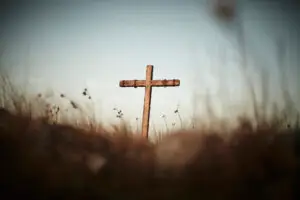I, Verses 1-5 – The Search in Heaven for a Worthy One
A. Note the interplay between power and worthiness
1. Both the images of throne and right hand denote power, invincibility. This is the one who has created all things and who upholds all things. He is omnipotent.
2. Its being sealed with seven seals indicates virtual impenetrability. Seven seals means that it is perfectly secured from its writing being revealed.
3. The call for one to open the scroll comes from a mighty angel. Clearly, if a merely created being endowed with extraordinary strength could open the scroll, then this one could do it.
4. His call is for one that is worthy. “Who is worthy to open the scroll and break its seals?” The power to open must be an undiluted moral power.
5. Verses 3 and 4 show the interplay between the ability to open the scroll and the worthiness to do it. “And no one in heaven or on earth or under the earth was able to open the scroll . . . no one was found worthy to open the scroll.” Because that which unfolds when the seven seals are broken all concern God’s sure judgment on the world as a manifestation of the infinite blessings given to the redeemed, only one that is morally worthy of accomplishing redemption has the intrinsic authority, the ability, the power, to bring to pass the scenes in the scroll.
B. The Scroll
1. Written within and on the back, no space is omitted in the composition of this scroll. It contains, in principle, a full narrative of the events in the world concerning the redemptive glory of the One that is viewed as worthy to open the scroll. In Psalm 139:16, David grasps the truth, “In your book were written, every one of them, the days that were formed for me, when as yet there were none of them.” Even so, on this scroll were written all the things that constitute the redemptive purpose of God.
2. Some will take this as a narrative of the years of the Great Tribulation. It seems to me that it provides various vignettes into the realities of this present fallen order in which there are a variety of trials and sometimes severe persecutions for the people of God that are sure to culminate with the protection of the redeemed and the just judgment of those that oppose God, his truth, and his people. We might be able to identify specific times when this has occurred—such as the early persecutions from the Jews and the persecution that comes from
3. Sealed with seven seals. This perfect sealing of the scroll has two applications
First, it means that the knowledge contained in it is hidden in the eternal counsels of God and can only be known through divine revelation. Without the worthy one, no one can “look into it.”
Second, the events themselves could not come to pass unless those events are set in motion by the one worthy to open the scroll. They are sealed and entire purpose of God in history will not, can not, happen apart from a worthy redeemer. No one else can “open the scroll.” Remember, John’s first sight of the one seated on the throne pointed him to the covenantal status of this revelation by the throne’s encirclement with a rainbow. The scroll could well represent the covenant of redemption embedded within the eternal consciousness and purpose of the triune God that comes to pass only in light of the means of the redemptive work of the Son of God. The struggle of the church against persecution as described in Hebrews is a microcosm of the broader picture set forth in staggering proportions by the apocalyptic symbols of Revelation. The summary of Hebrews 13:20, 21 applies to the events in the scroll. “Now may the God of peace who brought again from the dead our Lord Jesus, the great Shepherd of the sheep, by the blood of the eternal covenant, equip you with everything good that you may do his will, working is us that which is pleasing in his sight, through Jesus Christ, to whom be glory forever and ever. Amen.”
C. Who is the Worthy One?
1. The Lion of the Tribe of
2. The Root of David – Not only is he the heir of David, the final fruit of
3. He has conquered. He has accomplished all that makes him worthy of opening the sealed scroll. God’s redemptive purpose in history has been gradually unfolding in revelation from the very beginning and in essence was brought into being by the victory of the Lion: “God, who has saved us and called us to a holy calling, not because of our works but because of his own purpose and grace, which he gave us in Christ Jesus before the ages began, and which now has been manifested through the appearing of our Savior Christ Jesus, who abolished death and brought life and immortality to light through the gospel” (2 Timothy1:9, 10). He brought the knowledge of it to light by revelation and the essence of it to light by his victory over death and Satan.
II. Verse 6 – The Appearance of the Lion
A. His location –
1. The one upon whom John casts his eyes is inside the circle formed by the four living creatures around the throne (one “on each side of the throne”) and “among the elders” who sit on thrones inside the creatures and around the throne. In 1:13 we find Jesus “in the midst of the lampstands” and in 2:1 he “walks among the seven golden lampstands.” Jesus is with his people; he is with them on earth and he is their perfect representative in heaven.
2. He is standing, but not as a lion. He stands, clearly alive, as a lamb with clear evidence that he has been slain. This is a symbol of the power of moral perfection. Christ appears as a lion in the protection of his people, for he has shed his blood for them as the lamb of God in pursuit of their forgiveness on terms of perfect righteousness. As he stood at the martyrdom of Steven, controlling even those events in order to usher the slain witness into heaven, so his posture in this vision is standing in light of the persecution facing the churches.
B. His Authority
1. Though he had been slain, or perhaps because he had been slain, he has all authority, and his knowledge extends to all things. The vision of seven horns emphasizes his plenitude of power. At his ascension, in giving the final commission to his disciples, Jesus encouraged them with the words, “All authority has been given to me” (Matthew 28:18). This refers not just to his intrinsic authority as eternal Son of God, but to his authority to redeem as the Christ, the Son of Man. In Hebrews 1:3, 4, both of the aspects of his absolute authority are seen. “He is the radiance of the glory of God and the exact imprint of his nature, and he upholds the universe by the word of his power. After making purification for sins, he sat down at the right hand of the Majesty on high, having become as much superior to angels as the name he has inherited is more excellent than theirs.” The one is his absolutely and naturally; the other is granted because of his effectual execution of redemption. He is Jesus the Savior.
2. The image of seven eyes points to his knowledge of all things for all these events were contained in the eternal covenant. Intrinsic to the unifying nature of love within the Trinity was an implicit covenantal arrangement for an eternal display toward created intelligences the distinction of persons, the singularity of essence, and the infinite excellence and perfection of attributes of Himself, the one true God. Eternally privy to the all the necessary arrangements for such a display, the Son, as Son of God and Son of man in one person, has all knowledge of what is contained in the scroll.
3. That these are identified with the “seven spirits of God sent out into all the earth” refers to Christ’s sending of the Spirit to effect in his people all that has been purchased for them by the sacrifice of Christ. Christ claimed that his power extended to “heaven and earth.” His power in heaven is indicated, at least in once instance, by his having the right to send the Spirit to convict the world of sin, righteousness, and judgment. His power on earth is manifest by the Spirit’s giving life to those dead in trespasses and sins and by his secret, but invincible, operations in giving perseverance to Christians.
4. Note that the scroll that no one was worthy to take, was taken by the Lamb.
His taking it from the right hand of Him who sits on the throne shows the perfect unity of purpose and standing of the two persons so represented.
He demonstrates that his work of redemption has fully satisfied all the requirement of the eternal covenant so that he puts into effect everything that is contained in it, as written in the scroll.
III. The song of Redemptive Power and Worthiness from the Voices of Heaven
A. This action of the Lamb immediately beings about worship from the elders and the creatures. All the redeemed of all ages and every thing created recognizes the eternal glory of the Lamb and that the time has come when “the creation itself will be set free from its bondage to decay and obtain the freedom of the glory of the children of God” (Romans 8:21).
1. Each held a harp, symbolic of the beauty and perfect harmony of the worship of heaven. The harp with its loveliness of figure, the harmonic intervals of its strings, its fitness to encourage and support the voices of worshippers, shows the readiness [“each held”] of those in the heavenly state to culminate the reason for their being in a united manifestation of praise.
2. The prayers of the saints – the prayers of the saints symbolized by the bowls of incense indicate the element of worship that necessarily resides within prayer. No prayer has been wasted, no heart impulse for the glory of God to be demonstrated will be lost. “Thy will be done on earth as it is in heaven” is a petition whose time will certainly come. When “we do not know what to pray for as we ought” and the “Spirit intercedes for the saints according to the will of God,” (Romans 8:26, 27) we know that those prayers are gathered to be dispensed on the earth in accord with the will of God.
B. Their song focuses on the work of Christ’s giving his life a ransom for many (Mark 10:45).
1. Christ is praised for his worthiness to take the scroll and reveal its contents by breaking its seals.
2. His worthiness to do this stems from his work of redemption. “For your were slain” etc.
He was slain. That is, death was forced upon him as an act of retribution. By men he was slain on the basis of charges that had no substance. By his Father he was slain for he took upon himself the penalties justly deserved by those for whom he died.
By this sacrificial death, The Lamb ransomed, that is, redeemed by purchase, people unto God. They were purchased to be given to God. Since the price has been paid, the prisoner must be set free and given to the one for whom the purchase was made. Christ not only is the purchaser but his life is the purchase price.
Those so purchased were scattered throughout the world for he has redeemed them “out of” every language and people and nation. Not for the nation of
John repeats what he observed in chapter one, verse 5. “To him who loves us and has freed us from our sins by his blood and made us a kingdom, priests to his God and Father.” The redeemed are a kingdom over which the triune God reigns in grace and mercy. The citizens of this kingdom are priests “continually offer up a sacrifice of praise to God, that is, the fruit of lips that acknowledge his name” (Hebrews 13:15), and they offer their bodies as living sacrifices in the way of holiness as their spiritual worship (Romans 12:1).
They shall reign on earth – In accord with the promise made to the church in Laodicea, “The one who conquers, I will grant him to sit with me on my throne, as I also conquered and sat down with my Father on his throne” (Revelation 3: 21). It reflects the words of Jesus in Matthew 19:29-30. Paul also uses this truth as a means to chasten the Corinthian church for their failure to bring reconciliation to brothers using the secular law courts against each other (1 Corinthians 6:1-3). ). This is an assurance of the final victory of the Lamb over all forces that oppose his holy rule, and that those who have known and followed him will find that his victory is also theirs. As he rules as the Messiah who came for their sake, so all the rewards of his messianic accomplishment become the gracious privilege of his people.
IV. A Shout Succeeds the Song – Verses 11-14
A. This chorus of redemption now is joined by millions of angels. Though they have not received redemption, it is one of the things into which they have longed to look (1 Peter 1:10-12). All of the blessings of which the Lamb is worthy come to him as rewards for the full obedience he showed even unto death. The rewards he receives on the basis of his merits then come to his people as the blessings of grace. “power and wealth and wisdom and might and honor and glory and blessing!”
B. A new chorus begins with increased participants. This portion of the vision seems to thrust us forward to the final day. Seemingly there is nothing that has life or breath that has not joined this chorus. Even those living things under the sea give praise to him “who sits on the throne and to the Lamb.” The new heavens and the new earth will show forth the glory of God and bring to full manifestation their original purpose to witnessing to both the power and wisdom of God in his righteous rule over all things. The intent of Psalm 19:1-6 and Romans 1:20 is to show how clearly they witness to God’s glory even as nature has been subjected to vanity. When released from their bondage to decay the display of divine beauty in creation will give resounding and cascading shouts of acclamation to God, and even more greatly than in their state before the fall, for the resplendence of redemption will give added dimensions to their testimony. Philippians 2:9-11, when Paul sees that “at the name of Jesus every knee should bow, in heaven and on earth and under the earth, and every tongue confess that Jesus Christ is Lord, to the glory of God the Father,” gives a summary view of this scene.
C. John’s weeping (verse 4) has been replaced by the voices of all things giving glory to him that sits on the throne, who held the scroll that seemingly no one could open, and to the Lion/Lamb who was found worthy to open it. “And the four living creatures said, ‘Amen!’ and the elders fell down and worshiped.”
















